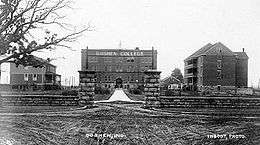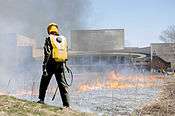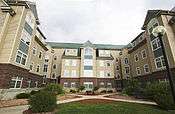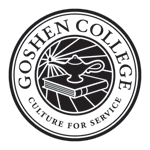Goshen College
|
The Seal of Goshen College | |
| Motto | Culture for Service |
|---|---|
| Type |
Private Liberal Arts |
| Established | 1894 |
| Affiliation | Mennonite Church USA |
| Endowment | $117,507,000[1] |
| President | Dr. James Brenneman |
Academic staff | 70 |
| Students | 839 |
| Undergraduates | 773 |
| Postgraduates | 66 |
| Location |
Goshen, Indiana, USA 41°33′49″N 85°49′38″W / 41.5637°N 85.8272°WCoordinates: 41°33′49″N 85°49′38″W / 41.5637°N 85.8272°W |
| Campus | Large town: 135 acres (0.5 km²) 1,189 acre Merry Lea |
| Athletics | 14 Division II NAIA teams |
| Colors | Purple and White |
| Nickname | Maple Leafs |
| Mascot | Maple Leaf |
| Website |
www |
 | |
Goshen College is a private liberal arts college in Goshen, Indiana. The institution was founded in 1894 as the Elkhart Institute of Science, Industry and the Arts, and is affiliated with Mennonite Church USA. The college is accredited by the Higher Learning Commission. U.S. News and World Reports ranks Goshen as a third-tier national liberal arts college.[2]
Goshen has an enrollment of around 775 students.[3] While Goshen maintains a distinctive liberal Mennonite worldview, it admits students of all religions. Its percentage of Mennonite students to other religious affiliations is 43/57.[3]
Goshen College is home to The Mennonite Quarterly Review and the Mennonite Historical Library, a 75,000 volume library compiling the most comprehensive collection of Anabaptist Mennonite primary source material in the United States
History
The history of Goshen College is intertwined with that of the Mennonite experience in America. Because both histories have been so important to each other, it is necessary to explain Goshen's stories as related to larger American and Mennonite society.
Goshen College is the first Mennonite school of higher education in North America to confer a four-year degree.[4] "Old" Mennonites had traditionally been suspicious of higher education, but by the late 19th century, opinion started to change. Decades earlier, U.S. mainline church denominations had started on a spree of founding colleges across America with hopes of developing well-trained clergy for their congregations. As more "Old" Mennonites sent their children to other Christian colleges, they realized that, without a college of their own, many of their youth would leave the church. Thus, prompted in part as a reaction to mainline Christianity, the "Old" Mennonites started the Elkhart Institute in Elkhart, Indiana in August 1894 to prepare Mennonite youth for college. Because of this vision, even though Goshen today is open to everyone, its historical relationship with the Mennonite Church has had a lasting impact that is still very visible: It is home to The Mennonite Quarterly Review, Mennonite Historical Library, Mennonite Church USA Archives, including Mennonite Central Committee archives, offices of "The Mennonite" and numerous alumni connections with the broader Mennonite Church.

H.A. Mumaw, a practicing physician, first led the small operation. In 1894, a group of 15 "Old" Mennonite ministers and laymen started a corporation that they named the Elkhart Institute association.[5] The first diploma was awarded in 1898. Lured by businessmen to relocate several miles away to Goshen, Indiana, the Institute moved in September 1903 and added a junior college course list, renaming itself Goshen College. By 1906, the Mennonite Board of Education took control of the college, dissolving the Elkhart Institute Association. A complete college course was established in 1908 and the first Bachelor of Arts degrees were conferred in 1910. The college-prep academy program of Goshen College was discontinued in 1935. However, after 1910, most of Goshen's students were enrolled in college courses. From 1914 to 1919, partly out of response to its constituents, Goshen College attempted a "School of Agriculture," which sought to prepare Mennonite young people to return to their rural communities. The hope was that such a program would spark a technological revolution among some of the farmers. Unfortunately the program was never a success and, after World War I, the program was cut, five years after it began.
The school was closed during the 1923-1924 school year by the Mennonite Board of Education but reopened the following year. One of many factors in closing the college was denominational tension due to modernist and fundamentalist Christian theologies of the 1920s and their impact on Mennonite theology at the school.[6] In response to this crisis, many of Goshen's faculty and dozens of students, angry with the Mennonite Board of Education's decision, relocated to Bluffton College. As part of the larger ongoing reaction against liberalism through the early 20th century, Hesston College and Eastern Mennonite School were formed among "Old" Mennonites, although staunch traditionalists realized that no higher education was particularly safe.
When the institution was reopened, it was marked by the new leadership of president S.C. Yoder and dean Harold S. Bender, a man whose influence upon the "Old" Mennonites was significant for much of the 20th century. Bender carefully piloted the stormy waters of theology by stating that Mennonitism was not liberalism. Bender later went on to say that fundamentalism also contributed to problems with theology and created The Anabaptist Vision, a "third way" that sought to spell out the direction for the future Mennonite Church. More than arguing doctrine, Bender and a younger group of intellectuals at Goshen College sought to shape the Mennonite faith that was more ideological than institutional. The goal was to articulate a faith that could stand the test of academic scrutiny in broader society while carefully upholding traditional beliefs of the church. Out of this ideology, Bender started The Mennonite Quarterly Review. Throughout this time, Goshen remained the epicenter of "Old" Mennonite theology and higher education, and became known as the "Goshen Historical Renaissance".[7]

During the 1940s, Goshen was one of the Mennonite Central Committee's key places to form a "relief training school" that helped to train volunteers for unpaid jobs in the Civilian Public Service, an alternative to the Army. Many Mennonites chose the civilian service alternative because of their beliefs regarding Biblical pacifism and nonresistance. Although the young women pacifists were not liable to the draft, they volunteered for unpaid Civilian Public Service jobs to demonstrate their patriotism; many worked in mental hospitals.[8]
In 1980, the college was granted care of Merry Lea Environmental Learning Center, a 1,150-acre (4.7 km2) nature preserve that now offers Goshen's master's degree in Environmental Science.
In 1993, Harold and Wilma Good, longtime friends of the college, left their estate to Goshen. The estate was estimated at roughly $28 million, the majority in stock of the J.M. Smucker Company. Wilma was a daughter of the company's founder. The college sold the stock and added the funds to its endowment, more than doubling it.[9]
The campus experienced a building boom in the later half of the 1990s through the present, with an estimated $30 million in new or renovated structures on campus. This included the addition of the Roman Gingerich Recreation-Fitness Center, the Music Center, the Connector, and the renovation of all dormitories. The college is currently working on a new campus master plan and strategic plan that will define the college's priorities for the years ahead. Today, more than 20,000 Goshen College alumni have been counted, residing in more than 85 countries. The Goshen campus has flourished from less than 50 acres (200,000 m2) to 135 acres (0.55 km2) with 18 major buildings.[10]
Academics
Goshen College offers 41 majors and 47 minors for undergraduates.[11] Some of the most popular programs are nursing, biology, business, communication, education, American Sign Language and environmental science. The college also offers a Master of Arts in Environmental Education, a master's degree in intercultural leadership, and a master's degree in nursing with two tracks: family nurse practitioner and clinical nurse leader.[12] In 2014, Goshen College partnered with Eastern Mennonite University and Bluffton University to launch the Collaborative MBA program.[13]
Goshen College also offers a variety of pre-professional programs:
- Pre-Architecture
- Pre-Dentistry
- Pre-Engineering
- Pre-Law
- Pre-Medicine
- Pre-Pharmacy
- Pre-Physical Therapy
- Pre-Seminary
- Pre-Veterinary
The academic year is divided into two semester terms, with an additional May term.
Study-Service Term

Intercultural education is a requirement for all students at Goshen College. To fulfill the requirement, students will either spend a semester abroad or complete an intercultural experience in the United States. Goshen College's Study-Service Term (SST) is a program which approximately 80 percent of students participate in to complete their intercultural study requirement.[14]
Students typically study the language and culture for six weeks, usually in the capital city, then do some sort of service work in a more remote area for the remaining six weeks. Service may include working at a hospital, nursing home, kindergarten, or missionary service.[15] Goshen College students currently may visit Cambodia, China, Peru, Senegal, and Tanzania. Previous SST locations include Belize, Costa Rica, Cuba, Dominican Republic, El Salvador, Egypt, Ethiopia, Germany, Haiti, Honduras, Indonesia, Ivory Coast, Jamaica, Mali, Morocco, Nicaragua, Poland, and South Korea. The college has in the past also offered a domestic SST to immerse students in the Latino culture and community in northern Indiana.[16]
Student life
Athletics
Goshen College athletic teams are known as the "Maple Leafs," chosen due to the city of Goshen being referred to as "The Maple City."
Goshen is a member of the NAIA and competes in the Crossroads League (formerly known as the Mid-Central College Conference[17]). Men's sports include baseball, basketball, cross country, soccer, tennis, and track & field; while women's sports include basketball, cross country, soccer, softball, tennis, track & field, and volleyball.[18]
Intramurals are also offered. Throughout the year, students can participate in the coed sports of outdoor soccer, volleyball, sand volleyball, kickball, touch football, ultimate frisbee, and wiffleball as well as basketball, indoor soccer, and 3-on-3 basketball.[19]
Clubs and organizations
Goshen College has no official fraternities or sororities, however, many different types of clubs and organizations exist to help facilitate campus life. Clubs that play a significant part in campus life include: Black Student Union (BSU), Latino Student Union (LSU), International Student Club (ISC), Advocates, GC Players, Nursing Student Association, Hymn Club, Voices and Harmony, Social Work Action Association (SWAA), Art Club, Pre-Med Club, Goshen Student Women's Association (GSWA), PAX and Eco-PAX.
Campus Activities Council, or CAC, is the primary extracurricular organization on campus that hosts a variety of weekend activities and events. CAC is responsible for "Kick Off," a talent show held at the beginning of each semester. CAC also hosts "Hour After" shows, where talented students on campus perform music, comedy, or dancing for the audience.
International students
The International Students Club (ISC) hosts the Coffeehouse every year, an event during which international students demonstrate their artistic talents. Students are also given the opportunity, through Global Citizenship, to individually talk about their culture, and have it published by the Goshen College newspaper.
Media

Goshen College has its own school newspaper, The Record and its own radio station, WGCS, branded as 91.1FM The Globe. On March 12, 2011, The Globe was named the Best College Station in the Nation, winning first place at the 71st Annual Conference of the Intercollegiate Broadcasting System (IBS) in New York City. On March 2, 2013, The Globe was again named Best College Station in the Nation, making it the first college to win the award twice. Goshen College Television (GCTV) produces a bi-weekly news show, "The Correspondent", which covers campus and community news. GCTV has also been involved in several larger projects, including the broadcast of the school's annual Festival of Carols on WNIT. In the summer of 2011, the Goshen College communication department launched FiveCore Media, a video production company aimed at providing services for both on-campus and off-campus clients. Every year Goshen College publishes the Maple Leaf, the school's yearbook, created, designed and managed by students. The Maple Leaf gives a glimpse of the academic year and provides documentation of the school's history.
Performing arts
Goshen College students have a variety of shows to attend in the Music Center's Sauder Concert Hall or Rieth Recital Hall or the Umble Center, Goshen's theater. With the addition of the Music Center to campus, the college has offered a Performing Arts Series of nationally renowned artists from across the country. Previous guests include Garrison Keillor and A Prairie Home Companion, Indigo Girls, The Wailin' Jennys, Nickel Creek, Colm Wilkinson, Chanticleer, Canadian Brass, Tokyo String Quartet, and Lincoln Center Jazz Orchestra with Wynton Marsalis.
Spiritual life
Because Goshen is a Christian college, spirituality plays an important part of campus life. Although Goshen maintains that people of different faiths are welcome to the college, the school emphasizes Judeo-Christian values in regard to operation, justice, and teaching. All faculty members at the school are Christian, with at least eighty percent adhering to Mennonite convictions. The College holds convocations or chapels every Wednesday, with occasional special events, such as Dr. Martin Luther King, Jr. Day. Students are required to attend half of these services per semester.
Goshen College operates a campus ministries team, headed by the campus pastor. The team includes an assistant campus minister and student leaders who help guide and plan spiritual life on campus for the school year. Activities include managing the network of Goshen's small groups, spiritual friendship, leading campus worship, and planning chapels. Campus worship night is a voluntary praise and reflection time held every Wednesday night. Students also hold a Taizé prayer service once a month on Sunday nights at 9:00. Because service is an important aspect of Christian faith, volunteerism ties in with spiritual life on campus.
Volunteerism
Every September, Goshen College participates in an activity called Celebrate Service Day (CSD). Students team with professors and administrative faculty and go out into the larger Goshen community for a day of service. First year students go with their colloquium advisers, while other students go with their dormitory floor or small group. Aside from CSD, many students donate their time to work at local kindergartens, elementary schools, hospitals, and nursing homes.
Sustainability

In 2007, Goshen College President Jim Brenneman became a charter signatory to the American College & University Presidents Climate Commitment joining with leaders of 175 other higher education institutions that have agreed to neutralize greenhouse gas emissions on their campuses. In 2008, Rieth Village at Merry Lea Environmental Learning Center of Goshen College became the first platinum-rated LEED building in Indiana. In the spring of 2013, the college took the further step of purchasing 100 percent of its electricity from renewable sources through the procurement of renewable energy credits. A computerized building temperature regulation system, motion light sensors for indoor and outdoor lighting and open loop ground-source heat pumps further reduce energy consumption on campus. The campus has also converted nearly 20 percent of its lawn space to native plants and prairie restoration. Goshen College students and staff have developed a food composting system, planted a community garden, built a solar hot water collection system and continued to reduce energy consumption campus-wide. In 2014, the college earned a silver rating from the Sustainability Tracking, Assessment and Rating System (STARS) report for its sustainability efforts. Through an aggressive energy reduction program and efficiency upgrades, Goshen College has reduced electric consumption by 25 percent and gas consumption by 23 percent since 2007.
Campus facilities
Goshen College has four dormitories, apartment living, and several small group houses. Outside the original quadrangle, Goshen's current campus has not been the result of a single master plan; rather the campus has evolved eclectically from building to building as the institution grew.[20][21] Four-year residency was typical until the mid-1970s, when a growing student enrollment prompted school officials to forgo building new dormitories and allow upperclassmen to live off campus. In 2005, Goshen College announced its plan to return to four-year residency. With more students on campus, the school has spent over $10 million building and renovating dorms.
The Roman Gingerich Recreation and Fitness Center is a $7 million facility constructed in 1994 with three full-sized basketball courts, four racquetball courts, a 200-meter indoor track, (formerly) swimming pool (for recreational swimming only) and hot tub, climbing wall, and weight room. The fitness center is open to all students and staff, and is used by community members as well.
The $24 million Music Center, completed in October 2002, has become regionally renowned for its design and acoustics.[22][23] The Music Center consists of several main sections: Sauder Concert Hall, Rieth Recital Hall, the Art Gallery, and various classrooms, practice rooms and offices. Several highlights are a central recording studio, MIDI labs, and Taylor and Boody Opus 41, a 1600-pipe tracker pipe organ, the first in the world with tempering based on alumnus Bradley Lehman's research of Johann Sebastian Bach's notation.[24] The facility was designed by Mathes Brierre Architects (design architects), Schmidt Associates (architects of record), and TALASKE (acoustics and audio consultants).[25]
Small Group Housing

Small Group Housing (SGH) is an option for juniors and seniors on Goshen's campus. Started in the 1970s, SGH offers students the opportunity to live in a house arrangement, with common kitchen and living spaces. The purpose of SGH is for students to develop another living experience alternative to dormitory life. This same idea was carried out with the construction of the Apartments. Goshen College maintains that SGH living is a privilege, and students must apply as a group to live in a residence. An application board consisting of resident directors, spiritual life, and physical plant review all potential candidates in the spring for the next school year. Each group must create a housing plan, division of responsibility, show examples of volunteerism, and a commitment to better the Goshen campus, as well as resolve conflict. Other factors considered in the application process include house cumulative GPA, extracurricular involvement, median age of the group, and personal faculty recommendations.[26] Houses are then rewarded to applying groups who exemplify high academic, moral, and volunteer efforts, based on objective and subjective review.
Goshen College students have also lived in local housing not associated with the college.
Satellite facilities

Goshen College maintains Merry Lea Environmental Center and a marine lab in Florida.
Other properties maintained by Goshen College include: Brunk's Cabin, a retreat property complete with a lit sledding hill in Cass County, Michigan, Witmer Woods,[27] a 13-acre (53,000 m2) arboretum with over 100 native Indiana species, and the adjacent property College Cabin (Reservoir Place),[28] used for special events, along the Elkhart River and millrace.
Controversy
National anthem
On January 21, 2010, The President's Council announced a change to Goshen's long-standing policy, and thus allowing an instrumental version of the national anthem to be played prior to some college sporting events.[29][30] This decision led to numerous complaints from students, faculty and alumni. College art professor, John Blosser, was quoted saying, “It’s obviously about a battle. It’s rather violent. It’s about using violence to conquer and that would be something that many people here would have problems with.”[31]
In response, Goshen's Board of Directors reversed the President's Council decision on June 6, 2011, after seeking extensive input from the college community.[30]
The incident thrust Goshen College into the national limelight that June when several reports on Fox News publicized the fact that the college refused to play the national anthem, "The Star-Spangled Banner," at its athletic events. Two Goshen city councilmen publicly criticized the college, with one referring to the decision as "anti-American" and stating that "instead of living here in Goshen, they should go down and live in Cuba or Iran, then have them come back and see if their attitude has changed."[31] The college, loosely affiliated with Mennonite Church USA, which is traditionally a peace church, published an online fact sheet stating that "historically, playing the national anthem has not been among Goshen College's practices because of our Christ-centered core value of compassionate peacemaking seeming to be in conflict with the anthem’s militaristic language."[32][33][34]
The college's president, Dr. James E. Brenneman, announced on August 19, 2011 that as an alternative, "America the Beautiful" would be played before select athletic events.[30][35]
Same-sex marriage
Goshen, along with sister school Eastern Mennonite University, created a stir within the Christian college community in July 2015, when the two became the first Council for Christian Colleges and Universities (CCCU) member schools to add “sexual orientation” to their anti-discrimination policy, clearing the way for the hiring of practicing homosexuals. The decision created a rift in the CCCU, which lobbies among other things, on behalf of the rights of Christian schools to hire employees who adhere to orthodox Christian teachings on marriage.[36] Two CCCU member-schools – Union University and Oklahoma Wesleyan University (OKWU) – had already resigned from the organization in protest, and up to forty other member schools were poised to follow the lead of Union and OKWU, before Goshen and EMU voluntarily withdrew their membership from the organization.[36][37]
Notable people
Goshen's motto, "Culture for Service" is evident in many graduates and faculty. Below is a partial list of notable people who have been associated with the College:
- Roger N. Beachy (1966) - Director of the National Institute of Food and Agriculture (NIFA)
- Harold S. Bender - Author, Professor, College Dean, founder of Mennonite Quarterly Review
- Douglas Schwartzentruber (1978) - Medical Director of the Goshen Center for Cancer Care and named to the TIME Magazine's 2010 list of the 100 most influential people in the world[38]
- David P. Bartel (1982) - professor of biology at Massachusetts Institute of Technology
- Sofia Samatar (1993) - award-winning author of A Stranger in Olondria
- James C. Strouse (1999) - screenwriter and director
- Errick McCollum - American professional basketball player who plays for Galatasaray of the Turkish Basketball Super League
- Carrie Newcomer - American singer, songwriter and author who has received numerous awards for her music and related charitable activities
Center for Intercultural Teaching and Learning
On October 25, 2006, Goshen College announced that it was the recipient of a $12.5 million Lilly grant to create the Center for Intercultural Teaching and Learning (CITL).[39][40] The purpose of this grant was to research challenges that come with changing demographics in rural towns with small colleges. Goshen College is located in Elkhart County which had a large and rapidly growing Latino population at the time (12.6 percent of the population in 2006).[40] Despite growing minority populations, Indiana's minority enrollment in its colleges and universities has only increased two percent.[40]
Traditions
- Goshen's motto, "Culture for Service," was coined by president Noah E. Byers in 1903.
- Goshen's school colors, purple and white, were modeled after Northwestern University, where President Byers attended and after which he wanted to model Goshen.
- One of the college's many traditions is "sampling" sap from the city of Goshen's official Maple Tree, located on campus, and "testing" how many more weeks of winter there will be. Professors from the science department bring out their equipment with much fanfare to determine the official length of winter. In 2006, the maple tree was removed because of disease rotting the hardwood and was replaced by a new tree, now the official maple tree of Goshen. In 2007, new president Jim Brenneman replaced this tradition (which probably resulted in the early death of the maple) with "Weather or Not Day"; a day celebrating Northern Indiana's fickle weather.
- Early (1925) advertisements for the college were refreshingly direct. One said “Goshen [is] not the best college in the United States. But it is better than the rest for Mennonite young people.”[41]
College seal
Goshen College seal signifies the book that all alumni have signed since graduation, and the lamp signifies the enlightenment that comes with education. As a Christian school, the book also signifies the importance of word, as well as God's call for his people to be "light to the world."[42]
Gallery
- Kulp dormitory and Adelphian fountain
- Roman Gingerich Recreation and Fitness Center
- The connector connecting Kratz, Miller, and Yoder underclassmen dorms
- Goshen College in late summer
- Goshen College's Quadrangle in early morning fog
- Schrock Plaza and Harold and Wilma Good Library
- Kratz and Miller dormitories
- Coffman dormitory
References
- ↑ As of 2014. "Chronicle of Higher Education Sortable Endowments table by Fiscal Year 2013-2014". 2012 NACUBO-Commonfund Study of Endowments. National Association of College and University Business Officers. Retrieved August 21, 2015.
- ↑ "America's Best Colleges 2008: Goshen College: At a glance". US News and World Reports. 2008. Archived from the original on January 13, 2007. Retrieved 2008-03-16.
- 1 2 "Quick Facts about Goshen College". Goshen College. Retrieved August 13, 2016.
- ↑ Bethel College is older but did not originally grant four-year degrees. Bethel was incorporated in 1887 and opened at its present site in 1893.
- ↑ Schlabach, Theron F: Peace, Faith, Nation: Mennonites and Amish in Nineteenth Century America, page 300. Herald Press, 1988
- ↑ Juhnke, James C: Vision, Doctrine, War: Mennonite Identity and Organization in America 1890-1930, page 128. Herald Press, 1989
- ↑ Toews, Paul: Mennonites in American Society, 1930-1970: Modernity and the Persistence of Religious Community, page 88. Herald Press, 1996
- ↑ Rachel Waltner Goossen, Women Against the Good War: Conscientious Objection and Gender on the American Home Front, 1941-1947 (1997) pp 98-111
- ↑ "Mennonite college endowments lag behind". Mennonite Weekly Review. 2006. Archived from the original on 2007-09-28. Retrieved 2008-03-24.
- ↑ "History of Goshen College". Goshen College. Archived from the original on 2007-09-26. Retrieved 2008-03-24.
- ↑ "Majors and Minors". Goshen College. Retrieved 4 October 2011.
- ↑ "Goshen College to launch first master's degree program, in environmental education". Goshen.edu. 2006-10-11. Retrieved 2016-04-22.
- ↑ "Unique Collaborative MBA program launched from platform of three Mennonite institutions - EMU News | Eastern Mennonite University". Emu.edu. 2014-03-12. Retrieved 2016-04-22.
- ↑ "Study-Service Term – Intercultural Requirement". Goshen College. Retrieved August 19, 2016.
- ↑ "Study-Service Term – What is SST?". Goshen College. Retrieved August 19, 2016.
- ↑ "Study-Service Term – Destinations". Goshen College. Retrieved August 19, 2016.
- ↑ "Name and Logo". Crossroads League. Crossroads League. Retrieved August 16, 2016.
- ↑ "GoLeafs.net". GoLeafs.net. Goshen College Athletics. Retrieved August 16, 2016.
- ↑ "Intramurals". Goshen College. Goshen College. Retrieved August 16, 2016.
- ↑ "Archived copy". Archived from the original on July 24, 2011. Retrieved December 18, 2008.
- ↑ Residence life Archived August 7, 2009, at the Wayback Machine.
- ↑ "Goshen College Music Center". GC Music Center. 2014-06-20. Retrieved 2016-04-22.
- ↑ Construction Archived September 28, 2006, at the Wayback Machine.
- ↑ "Archived copy". Archived from the original on February 8, 2007. Retrieved February 9, 2007.
- ↑ Goshen College Music Center website Archived July 31, 2007, at the Wayback Machine.
- ↑ "Small Group Housing". Goshen College. Archived from the original on September 26, 2007. Retrieved 2008-04-18.
- ↑ Witmer Wood's Goshen College website Archived May 28, 2010, at the Wayback Machine.
- ↑ "Archived copy". Archived from the original on July 24, 2011. Retrieved August 22, 2008.
- ↑ Eyder Peralta (June 7, 2011). "Goshen College Bans National Anthem At Sporting Events : The Two-Way". NPR. Retrieved April 22, 2016.
- 1 2 3 "National Anthem at Goshen College | News & Events | GC". Goshen.edu. Retrieved April 22, 2016.
- 1 2 Starnes, Todd (June 7, 2011). "National Anthem Banned at Mennonite College's Sporting Events, Sparking Outcry". Fox News.
- ↑ "National Anthem Banned at Mennonite College's Sporting Events, Sparking Outcry". Fox News. June 7, 2011. Retrieved April 22, 2016.
- ↑ "College Bans 'Too Violent' National Anthem - National Anthem - Fox Nation". Fox News. August 26, 2011.
- ↑ Starnes, Todd. "College Bans National Anthem". Fox News Radio. Retrieved March 22, 2012.
- ↑ Oppenheimer, Mark (September 16, 2011). "Pacifist Goshen College Reconsiders the National Anthem". The New York Times.
- 1 2 Smietana, Bob; Lee, Morgan; Zylstra, Sarah Eekhoff (July 20, 2015). "Two CCCU Colleges to Allow Same-Sex Married Faculty" (online). Christianity Today. Retrieved August 19, 2016.
- ↑ Weber, Jeremy (September 21, 2015). "Peace Church Out: Mennonite Schools Leave CCCU to Avoid Same-Sex Marriage Split". Christianity Today. Retrieved August 19, 2016.
- ↑ "The 2010 Time 100". Time. 2010-04-29.
- ↑ "Center for Intercultural Teaching and Learning". Retrieved 2007-12-25.
- 1 2 3 Aguirre, Richard: "Access, Transformation & Research", Bulletin: The magazine of Goshen College, Winter/Spring 2007, pp. 11-12
- ↑ "Archived copy". Archived from the original on September 27, 2007. Retrieved April 6, 2007.
- ↑ "One remarkable year: 1903-1904". Goshen College. 2003. Retrieved 2008-07-18.
